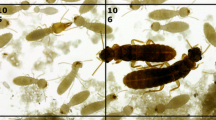Summary
Behaviour of Coenagrion resolutum nymphs was studied in the laboratory. Based on characteristics of the behaviour, analysis of the effects of inter-nymph distance on behaviour, and association analysis between behaviours, some of the observed behaviours were classified as grooming, feeding/aggression, retreat, or defense.
In an experiment on use of space, some nymphs excluded others from feeding areas through aggressive interactions. Frequency of interactions won by those nymphs seen most often at the feeding site was not associated with location of interactions. However, use of the feeding area was positively associated with dominance status. Exclusion of some nymphs is interpreted as a combination of dominance and limited movement rather than a territorial system.
Similar content being viewed by others
References
Ågren G (1976) Social and territorial behaviour in the mongolian gerbil (Meriones unguiculatus) under seminatural conditions. Biol Behav 1:267–285
Akre BG, Johnson DM (1979) Switching and sigmoid functional response curves by damselfly naiads with alternative prey available. J Anim Ecol 48:703–720
Altmann J (1974) Observational study of behaviour: sampling methods. Behaviour 49:227–267
Baker RL (1980) Use of space in relation to feeding areas by zygopteran nymphs in captivity. Can J Zool 58:1060–1065
Benke AC (1976) Dragonfly production and prey turnover. Ecology 57:915–927
Benke AC (1978) Interactions among coexisting predators — a field experiment with dragonfly larvae. J Anim Ecol 47:335–350
Brown JL (1975) The Evolution of Behaviour. WW Norton New York
Clifford HF (1969) Limnological features of a northern brown-water stream, with special reference to the life histories of the aquatic insects. Am Mid Nat 82:578–597
Corbet PS (1962) A Biology of Dragonflies. Whiterby London
Johnson DM (1973) Predation by damselfly naiads on cladoceran populations: fluctuating intensity. Ecology 54:251–268
Johnson DM, Akre BG, Crowley PH (1975) Modelling arthropod predation: wasteful killing by damselfly naiads. Ecology 56:1081–1093
Lawton JH, Beddington JR, Bonser R (1974) Switching in invertebrate predators. In: MB Usher, MH Williamson (eds) Ecological Stability. Chapman and Hall London, pp 141–158
Lehner PN (1979) Handbook of Ethological Methods. Garland STPM Press New York
Macan TT (1973) Ponds and Lakes. George Allen and Unwin Ltd. London
Macan TT (1977) The influence of predation on the composition of fresh-water animal communities. Biol Rev Cambridge Philos Soc 52:45–70
Murie JO, Harris MA (1978) Territoriality and dominance in male Columbian ground squirrels (Spermophilus columbianus). Can J Zool 56:2402–2412
Rowe RJ (1980) Territorial behaviour of a larval dragonfly Xanthocnemis zealandica (McLachlan) (Zygoptera: Coenagrionidae). Odonatologica 9:285–292
Slater PJB (1978) Data collection. In: PW Colgan (ed) Quantitative Ethology John Wiley and Sons, Inc New York
Thompson DJ (1975) Towards a predator-prey model incorporating age structure: the effects of predator and prey size on the predation of Daphnia magna by Ischnura elegans. J Anim Ecol 44:907–916
Thompson DJ (1978) Towards a realistic predator-prey model: the effect of temperature on the functional response and life history of larvae of the damselfly, Ischnura elegans. J Anim Ecol 47:757–767
Wickler W (1968) Mimicry in Plants and Animals. McGraw-Hill Toronto
Willis ED (1967) The behaviour of bicolored antbrids. Univ Calif Berkeley Publ Zool 79:1–132
Wilson EO (1975) Sociobiology, The New Synthesis. Harvard University Press Cambridge
Wolf LL (1970) The impact of seasonal flowering on the biology of some tropical hummingbirds. Condor 72:1–14
Author information
Authors and Affiliations
Rights and permissions
About this article
Cite this article
Baker, R.L. Behavioural interactions and use of feeding areas by nymphs of Coenagrion resolutum (Coenagrionidae: Odonata). Oecologia 49, 353–358 (1981). https://doi.org/10.1007/BF00347597
Accepted:
Issue Date:
DOI: https://doi.org/10.1007/BF00347597




